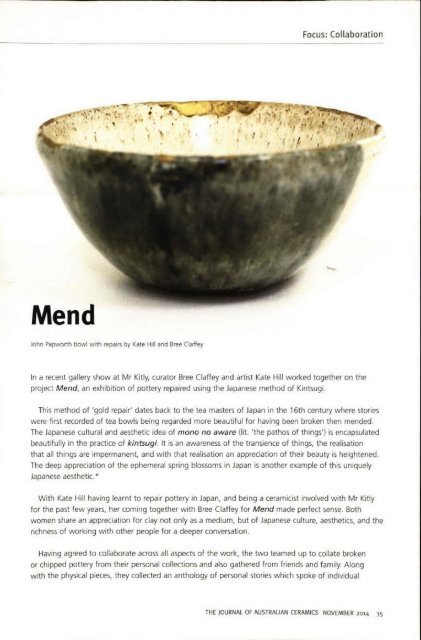The Journal of Australian Ceramics Vol 53 No 3 November 2014
You also want an ePaper? Increase the reach of your titles
YUMPU automatically turns print PDFs into web optimized ePapers that Google loves.
Focu s: Collaboration<br />
Mend<br />
John Papworth bowl with repa irs by Kate Hill and Bree Claffey<br />
In a recent gallery show at Mr Kitly, curator Bree Claffey and artist Kate Hill worked together on the<br />
project Mend, an exhibition <strong>of</strong> pottery repaired using the Japanese method <strong>of</strong> Kintsugi.<br />
This method <strong>of</strong> 'gold repair' dates back to the tea masters <strong>of</strong> Japan in the 16th century where stories<br />
were first recorded <strong>of</strong> tea bowls being regarded more beautiful for having been broken then mended.<br />
<strong>The</strong> Japanese cultural and aesthetic idea <strong>of</strong> mono no aware (lit. 'the pathos <strong>of</strong> things') is encapsulated<br />
beautifully in the practice <strong>of</strong> kintsugi. It is an awareness <strong>of</strong> the transience <strong>of</strong> things, the realisation<br />
that all th ings are impermanent. and with that realisation an appreciation <strong>of</strong> their beauty is heightened.<br />
<strong>The</strong> deep appreciation <strong>of</strong> the ephemeral spring blossoms in Japan is another example <strong>of</strong> th is uniquely<br />
Japanese aesthetic. *<br />
W ith Kate Hill having learnt to repair pottery in Japan, and being a ceramicist involved with Mr Kitly<br />
for the past few years, her coming together with Bree Claffey for Mend made penect sense. Both<br />
women share an appreciation for clay not only as a medium, but <strong>of</strong> Japanese culture, aesthetics, and the<br />
richness <strong>of</strong> working with other people for a deeper conversation .<br />
Having agreed to collaborate across all aspects <strong>of</strong> the work, the two teamed up to collate broken<br />
or chipped pottery from their personal collections and also gathered from friends and fam ily. Along<br />
with the physical pieces, they collected an anthology <strong>of</strong> personal stories which spoke <strong>of</strong> individual<br />
THE JOURNAL OF AUSTRALIAN CERAMICS NOVEMBER <strong>2014</strong> 35

















